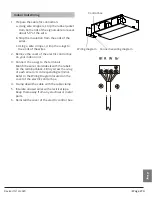
Instructions for Connecting Piping to
Indoor Unit
1. Align the center of the two pipes that you will
connect. See
Fig. 5.7.
2. Tighten the flare nut as tightly as possible by
hand.
3. Using a spanner, grip the nut on the unit
tubing.
4. While firmly gripping the nut on the unit
tubing, use a torque wrench to tighten the
flare nut according to the torque values in the
Torque Requirements table below. Loosen
the flaring nut slightly, then tighten again.
Note: Use of an approved refrigerant sealant is
recommended for all flare joint connections.
Step 4: Connect pipes
When connecting refrigerant pipes, be careful not
to use excessive torque or to deform the piping in
any way. You should first connect the low-pressure
pipe, then the high-pressure pipe.
MINIMUM BEND RADIUS
When bending connective refrigerant piping,
the minimum bending radius is 4in. See
Fig.5.6.
≥4in
Radius
Fig 5.6
Fig 5.8
Indoor unit tubing
Flare nut
Pipe
Fig 5.7
Torque Requirements
Outer Diameter of Pipe (inch)
Tightening Torque (ft/lb)
Add. Tightening Torque (ft/lb)
1/4"
11 ft/ lb
12 ft/ lb
3/8"
18 ft/ lb
20 ft/ lb
1/2"
25 ft/ lb
26 ft/ lb
5/8"
33 ft/ lb
35 ft/ lb
Excessive force can break the nut or damage the refrigerant piping. You must not exceed torque
requirements shown in the table above.
DO NOT USE EXCESSIVE TORQUE
Refrigerant Piping
Connection
Page 25
Revised 5/14/2020























